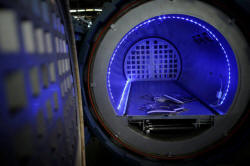|
New Russian jet heralds
carbon manufacturing shake-up
 Send a link to a friend
Send a link to a friend
 [May 30, 2017]
By Tim Hepher [May 30, 2017]
By Tim Hepher
PARIS
(Reuters) - Russia's new jetliner, which conducted its maiden flight on
Sunday, may have a hard time challenging the sales duopoly of Boeing and
Airbus, but it does point the way to radical changes in how they could
be building jets in the future.
The MS-21, a new single aisle airliner produced by Russia's United
Aircraft Corporation, is the first passenger plane borne aloft by
lightweight carbon-composite wings built without a costly pressurized
oven called an autoclave.
The manufacturing process provides a test for a technology already being
assessed by Western rivals, who are looking for cheaper and faster ways
to build some of their aircraft with composites, according to aerospace
executives and suppliers.
Even as it sets up the world's largest autoclaves to make wings for its
giant 777X, Boeing is exploring alternatives for its "New Midsize
Airplane" (NMA), in the middle of the market between its big wide-body
jets and best-selling 737.
"There's a good chance part of the NMA will be built without
autoclaves," a person familiar with the project said.
A Boeing spokesman said it was studying mid-market opportunities and
declined further comment.

Sources say Boeing's choice of technology for its two-aircraft NMA
family will lay the foundation for the next generation of its
money-spinning 737, expected to appear from 2030 and last well into the
second half of the century.
Boeing has not yet discussed this part of its strategy publicly, but
industry sources said it may include a trio of jets seating 160 to 210
people and built using broadly the same production system as the one
developed for the NMA.
Both families of planes are likely to be built for 30 years and stay in
service for another 20-30. So today's technology choices represent a
colossal 75-year bet.
Airbus too is monitoring the technology as it considers how to respond
to Boeing's mid-market jet, CNN reported last month. Airbus has declined
to comment on the report.
PIVOTAL DECISION
Composites have been used in aviation since the 1970s but achieved a
breakthrough in the past decade as the Boeing 787 Dreamliner and Airbus
A350 entered service, promising to save money on fuel by replacing most
metal parts with lighter carbon.
Those are long-haul jets, which means that the savings on fuel are
worthwhile even though the planes are expensive to build. For short-haul
planes that burn less fuel, like the NMA or future 737, it is more
important to find cheaper ways to build them, and avoiding the need for
autoclaves could help.
Betting on technology that does not require an autoclave is a gamble
also for composite suppliers like U.S.-based Hexcel <HXL.N>, Solvay <SOLB.BR>
of Belgium and Toray <3402.T> of Japan, whose share of aerospace
manufacturing is growing.
At a recent JEC composites fair in Paris, Hexcel and Solvay showcased
out-of-autoclave prototype parts as they gear up to supply manufacturers
on a bigger scale.
"It's one of the big questions now in aerospace: how to produce
out-of-autoclave on a large scale and at high speeds," said Henri
Girardy, business development manager at Hexcel Composites, adding
jetmakers would accept no cut in performance.

[to top of second column] |

An autoclave is displayed by California-based ASC Process Systems at
the JEC World exhibition at Villepinte, outside Paris, France, March
16, 2017. REUTERS/Christian Hartmann/File Photo

Boeing's Dreamliner and the Airbus A350 are built from carbon fiber already
impregnated with resin, called "prepreg", which is supplied to jetmakers,
tailored by machines into plane parts and cured inside giant pressure-cooking
autoclaves.
Analysts say these parts cost around 30-40 percent more to produce than
aluminum.
Under the new technology, instead of using fiber that is pre-impregnated with
resin, parts are made from a dry-fiber engineered textile which is placed in a
mould and then infused with resin under a vacuum.
The
parts can then be cured in an oven without pressure, a process estimated to cost
25 percent more than metal. Ultimately, that gap needs to narrow significantly
or disappear.
Boatbuilders and windfarm makers have used this method for years. Secondary
airplane parts have also been made that way.
But although Canada's Bombardier partly used the technique for its CSeries, it
was rare for flight-critical parts before the designers of the new Russian plane
chose it for the wing.
The MS-21 has yet to score large sales but has been able to catch onto the
latest manufacturing wave at a time when Western giants are starting to think
beyond their recently upgraded models to future designs.
"This is an excellent technology demonstrator because it is on a real programme
and a primary-structure part," said Frank Nickisch, global director of strategic
projects at Solvay Composite Materials, which provided materials for the MS-21.

He
noted that the wings on the MS-21 are of comparable size to a Boeing 737 or
Airbus A320.
Still, more needs to be done to bring down costs. And composite firms are not
yet ready to support output at speeds planemakers have in mind.
Industry sources say Boeing is expected to build 20-30 of its proposed
mid-market planes a month, about twice the rate for the 787. Future 737 and A320
replacements are likely to be closer to the 60-80 mark.
Nickisch said the proposed new Boeing middle-market aircraft would be a good
test case for whether the industry can switch to a higher tempo using the widely
expected composites.
Yet tough planemaker targets on cost, performance and output require progress on
three fronts: cheaper materials, wider automation and computer simulation to
ensure new technology works first time, following widespread delays with new jet
programmes.
"Prepreg technology has been developing for 40 years, based on day-to-day
knowledge. But to bring in a new process we need to be able to predict it first,
with databanks," Girardy said.
For graphic on how single-aisle jets compare http://tmsnrt.rs/2qyEV0W
(Writing by Tim Hepher; Editing by Peter Graff)
[© 2017 Thomson Reuters. All rights
reserved.] Copyright 2017 Reuters. All rights reserved. This material may not be published,
broadcast, rewritten or redistributed. |